Bion (original) (raw)

Home - Search - Browse - Alphabetic Index: 0- 1- 2- 3- 4- 5- 6- 7- 8- 9
A- B- C- D- E- F- G- H- I- J- K- L- M- N- O- P- Q- R- S- T- U- V- W- X- Y- Z
Bion
Russian biology satellite. Bion was developed for biological studies of the effects of radiation. Life Science satellite built by TsSKB > TsSKB-Progress, Russia. Launched 1973 - 1996. Used Zenit Bus.
AKA: 12KS. Status: Operational 1973. First Launch: 1973-10-31. Last Launch: 1996-12-24. Number: 11 . Payload: 625 kg (1,377 lb). Gross mass: 5,400 kg (11,900 lb).
The Bion series were built by TsSKB with experimental payloads by the Institute of Medical and Biological Problems. The spacecraft was based on the Zenit reconnaissance satellite and launches began in 1973. Launches in the program included Cosmos 110, 605, 670, 782, plus 11 autonomous Nauka modules flown on Zenit-2M reconnaissance satellites. 90 kg of equipment could be contained in the external Nauka module.
More at: Bion.
Family: Biology, Surveillance orbit. Country: Russia. Engines: 11D82M. Launch Vehicles: R-7, Soyuz-U, Soyuz-U-PVB. Launch Sites: Plesetsk, Plesetsk LC41/1, Plesetsk LC43/4, Plesetsk LC43/3. Agency: MOM, Kozlov bureau. Bibliography: 102, 104, 2, 297, 374, 4, 445, 6, 6388, 12156.
Photo Gallery
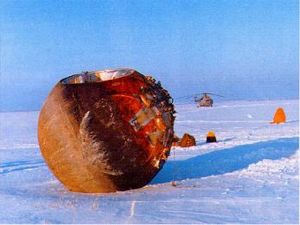 |
Bion RecoveryCredit: TsSKB |
|---|
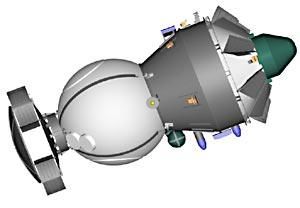 |
Bion CutawayCredit: TsSKB |
|---|
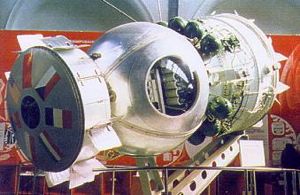 |
BionCredit: TsSKB |
|---|
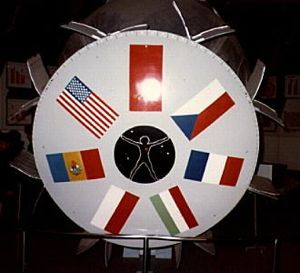 |
Cosmos 782 / BionCredit: © Mark Wade |
|---|
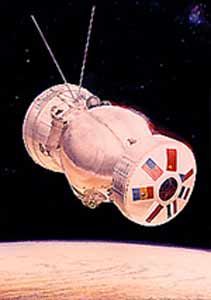 |
Bion No. 11Credit: Manufacturer Image |
|---|
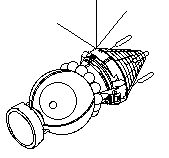 |
BiosatCredit: © Mark Wade |
|---|
1973 October 31 - . 18:24 GMT - . Launch Site: Plesetsk. Launch Complex: Plesetsk LC43/3. LV Family: R-7. Launch Vehicle: Soyuz-U.
- Cosmos 605 - . Payload: Bion no. 1. Mass: 6,000 kg (13,200 lb). Nation: Russia. Agency: MOM. Class: Biology. Type: Biology satellite. Spacecraft Bus: Vostok. Spacecraft: Bion. Duration: 21.50 days. Decay Date: 1973-11-22 . USAF Sat Cat: 6913 . COSPAR: 1973-083A. Apogee: 403 km (250 mi). Perigee: 213 km (132 mi). Inclination: 62.80 deg. Period: 90.70 min. Investigation of the influence of space flight on living organisms and testing of life-support systems for biological entities. Capsule recovered 53 deg 29 min N, 65 deg 27 min E..
1974 October 22 - . 18:00 GMT - . Launch Site: Plesetsk. Launch Complex: Plesetsk LC43/4. LV Family: R-7. Launch Vehicle: Soyuz-U.
- Cosmos 690 - . Payload: Bion no. 2. Mass: 6,000 kg (13,200 lb). Nation: Russia. Agency: MOM. Class: Biology. Type: Biology satellite. Spacecraft Bus: Vostok. Spacecraft: Bion. Duration: 20.50 days. Decay Date: 1974-11-12 . USAF Sat Cat: 7478 . COSPAR: 1974-080A. Apogee: 364 km (226 mi). Perigee: 215 km (133 mi). Inclination: 62.80 deg. Period: 90.30 min. Biological research. Investigation of the upper atmosphere and outer space. .
1975 November 25 - . 17:00 GMT - . Launch Site: Plesetsk. Launch Complex: Plesetsk LC43/3. LV Family: R-7. Launch Vehicle: Soyuz-U.
- Cosmos 782 - . Payload: Bion no. 3. Mass: 6,000 kg (13,200 lb). Nation: Russia. Agency: MOM. Class: Biology. Type: Biology satellite. Spacecraft Bus: Vostok. Spacecraft: Bion. Duration: 19.50 days. Decay Date: 1975-12-15 . USAF Sat Cat: 8450 . COSPAR: 1975-110A. Apogee: 384 km (238 mi). Perigee: 218 km (135 mi). Inclination: 62.80 deg. Period: 90.50 min.
Biological research. Continued investigation of the effects of space flight on living organisms. Capsule recovered 52 deg 17 min N, 64 deg 11 min E. The Cosmos 782 mission marked the first time that the United States participated in the Soviet Cosmos Program. Scientists from France, Czechoslovakia, Hungary, Poland, Romania, the U.S. and the U.S.S.R. participated in these investigations. Additional Details: here....
1977 August 3 - . 14:01 GMT - . Launch Site: Plesetsk. Launch Complex: Plesetsk LC43/3. LV Family: R-7. Launch Vehicle: Soyuz-U.
- Cosmos 936 - . Payload: Bion no. 4. Mass: 6,000 kg (13,200 lb). Nation: Russia. Agency: MOM. Class: Biology. Type: Biology satellite. Spacecraft Bus: Vostok. Spacecraft: Bion. Duration: 18.60 days. Decay Date: 1977-08-22 . USAF Sat Cat: 10172 . COSPAR: 1977-074A. Apogee: 396 km (246 mi). Perigee: 219 km (136 mi). Inclination: 62.80 deg. Period: 90.60 min.
Biological research. Scientists from the U.S.S.R., the U.S., Czechoslovakia, France, Hungary, Poland, Romania, Bulgaria and the German Democratic Republic conducted experiments in physics and biology on the mission. The biosatellite was recovered at 51 deg 53 min N, 61 deg 30 min E, near Kustanay in Central Asia after remaining in orbit for 18.5 days. Additional Details: here....
1979 September 25 - . 15:30 GMT - . Launch Site: Plesetsk. Launch Complex: Plesetsk LC41/1. LV Family: R-7. Launch Vehicle: Soyuz-U.
- Cosmos 1129 - . Payload: Bion no. 5. Mass: 6,000 kg (13,200 lb). Nation: Russia. Agency: MOM. Class: Biology. Type: Biology satellite. Spacecraft Bus: Vostok. Spacecraft: Bion. Duration: 18.50 days. Decay Date: 1979-10-14 . USAF Sat Cat: 11536 . COSPAR: 1979-083A. Apogee: 376 km (233 mi). Perigee: 213 km (132 mi). Inclination: 62.80 deg. Period: 90.40 min.
Biological experiments; embryo development, radiation medicine. Biosatellite for the continued investigation of the effects of space flight on living organisms. Capsule recovered 52 deg 17 min N, 65 deg 30 min E. Cosmos 1129 satellite carried biological and radiation physics experiment packages from Czechoslovakia, France, Hungary, Poland, Romania, the German Democratic Republic, the U.S. and the U.S.S.R. Additional Details: here....
1983 December 14 - . 07:00 GMT - . Launch Site: Plesetsk. Launch Complex: Plesetsk LC41/1. LV Family: R-7. Launch Vehicle: Soyuz-U.
- Cosmos 1514 - . Payload: Bion no. 6. Mass: 6,000 kg (13,200 lb). Nation: Russia. Agency: MOM. Class: Biology. Type: Biology satellite. Spacecraft Bus: Vostok. Spacecraft: Bion. Duration: 5.00 days. Decay Date: 1983-12-19 . USAF Sat Cat: 14549 . COSPAR: 1983-121A. Apogee: 255 km (158 mi). Perigee: 211 km (131 mi). Inclination: 82.30 deg. Period: 89.20 min.
Biological experiments. Continued investigation of the influence of space flight factors on living organisms. Carried monkeys Abrek and Bion. Capsule recovered 52 deg 42 min N, 62 deg 48 min E. The first U.S.S.R. orbital flight of a non-human primate was accomplished on the Cosmos 1514 mission. Two monkeys flew on the mission, together with several pregnant rats. More than 60 experiments were performed by investigators from Bulgaria, Hungary, the German Democratic Republic, Poland, Romania, Czechoslovakia, France, the U.S.S.R. and the U.S. U.S. scientists conducted three experiments on the primates and another experiment on the rat subjects. Additional Details: here....
1985 July 10 - . 03:15 GMT - . Launch Site: Plesetsk. Launch Complex: Plesetsk LC41/1. LV Family: R-7. Launch Vehicle: Soyuz-U.
- Cosmos 1667 - . Payload: Bion no. 7. Mass: 5,700 kg (12,500 lb). Nation: Russia. Agency: MOM. Class: Biology. Type: Biology satellite. Spacecraft Bus: Vostok. Spacecraft: Bion. Duration: 6.90 days. Decay Date: 1985-07-17 . USAF Sat Cat: 15891 . COSPAR: 1985-059A. Apogee: 262 km (162 mi). Perigee: 206 km (128 mi). Inclination: 82.40 deg. Period: 89.20 min.
Biological research. Carried monkeys Verniy and Gordiy. Continued investigations of the influence of space flight factors on living organisms and radiation physics research. Cosmos 1667 was the second USSR biosatellite mission with a primate payload. Cosmos 1667 also featured a large rodent payload, however the U.S. only conducted a single experiment cardiovascular experiment on one of the two flight monkeys. Mission parameters were very similar to those of Cosmos 1514. Countries participating in the mission included the USSR, U.S., France, Czechoslovakia, the German Democratic Republic, Poland, Romania, Bulgaria and Hungary. Additional Details: here....
1987 September 29 - . 12:50 GMT - . Launch Site: Plesetsk. Launch Complex: Plesetsk LC41/1. LV Family: R-7. Launch Vehicle: Soyuz-U-PVB.
- Cosmos 1887 - . Payload: Bion no. 8. Mass: 6,000 kg (13,200 lb). Nation: Russia. Agency: MOM. Class: Biology. Type: Biology satellite. Spacecraft Bus: Vostok. Spacecraft: Bion. Duration: 13.00 days. Decay Date: 1987-10-12 . USAF Sat Cat: 18380 . COSPAR: 1987-083A. Apogee: 382 km (237 mi). Perigee: 214 km (132 mi). Inclination: 62.80 deg. Period: 90.50 min. Biological research. Carried monkeys Drema and Erosha. Continued investigations of the influence of space flight factors on living organisms and radiation physics research. Capsule recovered 62 deg 47 min N, 112 deg 26 min E (?).. Additional Details: here....
1989 September 15 - . 06:30 GMT - . Launch Site: Plesetsk. Launch Complex: Plesetsk LC41/1. LV Family: R-7. Launch Vehicle: Soyuz-U-PVB.
- Cosmos 2044 - . Payload: Bion no. 9. Mass: 6,000 kg (13,200 lb). Nation: Russia. Agency: MOM. Class: Biology. Type: Biology satellite. Spacecraft Bus: Vostok. Spacecraft: Bion. Duration: 14.00 days. Decay Date: 1989-09-29 . USAF Sat Cat: 20242 . COSPAR: 1989-075A. Apogee: 264 km (164 mi). Perigee: 203 km (126 mi). Inclination: 82.30 deg. Period: 89.20 min.
29 US/USSR life science experiments conducted on monkeys, insects, plants, fish, rats. Carried monkeys Zhankonya and Zabiyaka. Cosmos 2044 was the seventh Soviet Biosatellite to orbit the Earth with joint U.S./U.S.S.R. experiments onboard. Hungary, the German Democratic Republic, Canada, Poland, Britain, Romania, Czechoslovakia and the European Space Agency also participated in the mission. The joint U.S./U.S.S.R. experiments were conducted on two rhesus monkeys and ten rats that were flown onboard the Biosatellite. The biological payload on the spacecraft also included fish, amphibians, insects, worms, protozoans, cell cultures and plants. Last launch from LC41. Additional Details: here....
1992 December 29 - . 13:30 GMT - . Launch Site: Plesetsk. Launch Complex: Plesetsk LC43/3. LV Family: R-7. Launch Vehicle: Soyuz-U-PVB.
- Cosmos 2229 - . Payload: Bion no. 10. Mass: 6,000 kg (13,200 lb). Nation: Russia. Agency: MOM. Class: Biology. Type: Biology satellite. Spacecraft Bus: Vostok. Spacecraft: Bion. Duration: 12.00 days. Decay Date: 1993-01-10 . USAF Sat Cat: 22300 . COSPAR: 1992-095A. Apogee: 372 km (231 mi). Perigee: 216 km (134 mi). Inclination: 62.80 deg. Period: 90.40 min.
Biological research; carried monkeys Ivasha and Krosha. International study of the adaptation of living organisms to conditions of space flight. After 12 days in Earth orbit, the capsule was recovered 50 deg 46 min N, 73 deg 08 min E, about 100 kilometers north of the city of Karaganda. The Cosmos 2229 mission was also referred to as Bion 10, because it was the tenth in a series of Soviet/Russian unmanned satellites carrying biological experiments. Additional Details: here....
1996 December 24 - . 13:50 GMT - . Launch Site: Plesetsk. Launch Complex: Plesetsk LC43/4. LV Family: R-7. Launch Vehicle: Soyuz-U-PVB.
- Bion No. 11 - . Payload: Bion No. 11. Mass: 5,400 kg (11,900 lb). Nation: Russia. Agency: RAKA. Class: Biology. Type: Biology satellite. Spacecraft Bus: Vostok. Spacecraft: Bion. Duration: 15.00 days. Decay Date: 1997-01-07 . USAF Sat Cat: 24701 . COSPAR: 1996-073A. Apogee: 375 km (233 mi). Perigee: 216 km (134 mi). Inclination: 62.80 deg. Period: 90.40 min. Biological research. Carried monkeys Lalik and Multik..
Home - Search - Browse - Alphabetic Index: 0- 1- 2- 3- 4- 5- 6- 7- 8- 9
A- B- C- D- E- F- G- H- I- J- K- L- M- N- O- P- Q- R- S- T- U- V- W- X- Y- Z
© 1997-2019 Mark Wade - Contact
© / Conditions for Use
